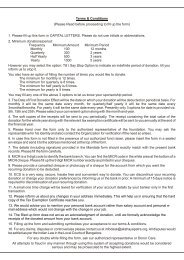The Top 100 NGOs 2013. - Akshaya Patra
The Top 100 NGOs 2013. - Akshaya Patra
The Top 100 NGOs 2013. - Akshaya Patra
Create successful ePaper yourself
Turn your PDF publications into a flip-book with our unique Google optimized e-Paper software.
DisuseD oxFam waTer<br />
Tanks in <strong>The</strong> DeserTeD<br />
mugunga camP in goma<br />
Being DismanTleD For use<br />
elsewhere in 1996.<br />
© un PhoTo/unhcr/hJ Davies<br />
<strong>The</strong> peace movement has the distinction<br />
of being responsible for the earliest<br />
recorded organization to actually<br />
describe itself as international. <strong>The</strong><br />
International Association created in<br />
Scotland in 1834 claimed to consist “of<br />
those who desire to find just grounds<br />
for mutual esteem and respect, – who<br />
cherish peace, – and will act upon<br />
the grand principle of collecting and<br />
disseminating such information as tends<br />
to meliorate the individual and social<br />
condition of their fellow creatures.”<br />
In the same year, Italian republican<br />
Giuseppe Mazzini established<br />
Young Europe for the promotion<br />
of nationalism, and communist<br />
revolutionaries united in their first<br />
international organization – the League<br />
of the Just – based in Paris.<br />
In the context of the proliferating<br />
associations of the 1830s, a young<br />
Frenchman introducing himself as<br />
“the Count of Liancourt,” Caliste-<br />
Auguste Godde, decided to set up an<br />
‘International Shipwreck Society’ in<br />
1835, modeled on the earlier Humane<br />
Societies and established “with a view to<br />
FeaTure FeaTure<br />
uniting the benevolent of all countries.”<br />
It proved hugely successful in collecting<br />
large subscriptions from members,<br />
and was run from Place Vendôme 16,<br />
next door to what is now the Paris Ritz.<br />
<strong>The</strong> society potentially contributed to<br />
the spread of more than 150 lifesaving<br />
societies across every continent, and<br />
published a journal, <strong>The</strong> International,<br />
marketed as “the intelligent organ of<br />
all civilized people.” Its activities were<br />
not to last long, however: in 1842 it<br />
was revealed that Godde – who turned<br />
out not to be a count, but in fact a<br />
provincial doctor from the village of<br />
Liancourt – had been using the society<br />
to line his own pockets.<br />
Whereas most of the international<br />
associations of the 1830s were to prove<br />
short-lived, the British and Foreign<br />
Anti-Slavery Society established in<br />
1839 has survived to the present day<br />
as the oldest international human<br />
rights organization, now Anti-Slavery<br />
International. Its significance extends<br />
beyond this achievement. British<br />
anti-slavery sentiment was one factor<br />
underpinning Whitehall’s failure to<br />
<strong>The</strong> gloBal Journal + January & FeBruary 2013<br />
recognize the Confederacy in the 1860s,<br />
playing a part in the abolition of slavery<br />
in the US. Similarly, the organization’s<br />
international Anti Slavery Convention<br />
held in London in 1840 was to spark a<br />
wave of private international congresses<br />
leading to the establishment of <strong>NGOs</strong> in<br />
many fields in subsequent decades. <strong>The</strong><br />
barring of women from the event also<br />
spurred two of the excluded delegates<br />
– Elizabeth Cady Stanton and Lucretia<br />
Mott – to convene a women’s rights<br />
convention at Seneca Falls in 1848,<br />
a key moment in the development<br />
of the international movement for<br />
women’s suffrage.<br />
Few individuals were to play a more<br />
critical role in the development of<br />
international <strong>NGOs</strong>, however, than<br />
Swiss philanthropist Henri Dunant.<br />
In 1855, he spearheaded the creation<br />
of the World Alliance of Young Men’s<br />
Christian Associations, notable for its<br />
pioneering structure as an international<br />
federation of national <strong>NGOs</strong>. More<br />
famously, after witnessing the carnage<br />
of the Battle of Solferino in 1859,<br />
Dunant went on in 1863 to found the<br />
Red Cross movement for the provision<br />
of neutral assistance to the wounded<br />
in conflict.<br />
In the period from the 1870s to World<br />
War I, there was a massive expansion in<br />
the number and variety of international<br />
<strong>NGOs</strong> parallel to the second industrial<br />
revolution. Among the more than<br />
400 bodies established at this time<br />
were organizations as diverse as the<br />
Universal Scientific Alliance, the World<br />
League for Protection of Animals,<br />
the International Council of Women,<br />
the International Federation of Trade<br />
Unions, the International Cooperative<br />
Alliance, the International Olympic<br />
Committee, Rotary International and<br />
the International Socialist Bureau.<br />
<strong>The</strong> achievements of international<br />
<strong>NGOs</strong> in the decades preceding the<br />
war included successful campaigns<br />
for new treaties, such as by the<br />
International Literary and Artistic<br />
Association in respect of international<br />
copyright, and by the International<br />
Abolitionist Federation in relation to sex<br />
trafficking. In addition, women’s groups<br />
were crucial in the dissemination of<br />
suffrage activism around the world.<br />
New Zealand, for instance, was the<br />
first country to grant women the<br />
right to vote in 1893. <strong>The</strong>re, the<br />
suffrage movement was stimulated by<br />
the American traveling envoy of the<br />
Woman’s Christian Temperance Union,<br />
Mary Leavitt.<br />
<strong>The</strong> late 19th century was an era in<br />
which the pan-nationalist ideas that<br />
were to have considerable influence<br />
on international politics in the 20th<br />
century began to be promoted by<br />
new <strong>NGOs</strong> such as the Pan-German<br />
League, the Pan-African Association,<br />
the Asia Association, the Pan Islamic<br />
Society and the World Zionist<br />
Organization. Widespread belief that<br />
national self-determination could lead<br />
to a more peaceful world was reflected<br />
in the creation in 1911 of a ‘Central<br />
Office of Nationalities,’ which aimed<br />
to promote “universal and perpetual<br />
peace” through its work on behalf of<br />
nationalist groups. More ominous was<br />
the development of organizations like<br />
the International Society for Racial<br />
Hygiene in 1905, and International<br />
Eugenics Committee in 1912, revealing<br />
the growing popularity of racist and<br />
eugenicist theories.<br />
With hindsight, the years immediately<br />
preceding the onset of World<br />
War I represented a period where<br />
internationalist idealism reached a<br />
denouement. Mass campaigns were<br />
launched around <strong>The</strong> Hague peace<br />
conferences of 1899 and 1907, with a<br />
global petition circulated by women’s<br />
organizations in 1899 amassing one<br />
million signatures. This sentiment was<br />
also reflected in the proliferation of<br />
associations dedicated to the promotion<br />
of international languages such as<br />
Esperanto, whose inventor, Lejzer<br />
Ludwik Zamhenhof, referred to himself<br />
as ‘Dr Hopeful.’ By 1911, numerous<br />
international <strong>NGOs</strong> had<br />
been created for Esperantists of<br />
different backgrounds, ranging<br />
from police employees to teachers,<br />
‘With hindsight,<br />
the years<br />
immediately<br />
preceding the<br />
onset of World<br />
War I represented<br />
a period where<br />
internationalist<br />
idealism reached a<br />
denouement’<br />
bankers, postal workers, and even an<br />
International Union of Esperantist<br />
Vegetarians, which, remarkably, has<br />
managed to survive to the present day.<br />
Of all the international <strong>NGOs</strong> to be<br />
established before the war, none was<br />
more ambitious than the Union of<br />
International Associations founded in<br />
1910, which described its goals as no<br />
less than “the representation of all…<br />
international associations in a federated<br />
body.” Its leaders laid ambitious plans<br />
for an “international palace” based in<br />
Brussels, “worthy of the importance<br />
of the organizations that created it.”<br />
Although its objective of uniting all<br />
international <strong>NGOs</strong> in a single global<br />
federation was to be cut short by<br />
mass conflict in Europe, the union<br />
succeeded in building its ‘international<br />
<strong>The</strong>gloBalJournal.neT<br />
32 33<br />
palace’ (now a car exhibition space),<br />
and survives to the present day as<br />
the principal data repository on<br />
international civil society organizations,<br />
publishing the annual Yearbook of<br />
International Organizations.<br />
Many groups failed to survive the<br />
devastating effects of World War I. At<br />
the same time, the vast destruction<br />
wrought by the conflict also spurred the<br />
formation of myriad new organizations<br />
to address its humanitarian<br />
consequences. <strong>The</strong> Save the Children<br />
Fund, for example, was established in<br />
1919 to provide relief for children in<br />
danger of starvation as a result of warinduced<br />
food shortages. In the same<br />
year, the organization now known as the<br />
International Federation of Red Cross<br />
and Red Crescent Societies emerged as<br />
another critical actor in the provision<br />
of post-war famine relief.<br />
Although most <strong>NGOs</strong> found it<br />
impossible to hold international<br />
conferences during the war, an<br />
important exception was to be<br />
found in the convening in 1915 of<br />
an international congress of more<br />
than 1,000 women at <strong>The</strong> Hague,<br />
who were later to form the Women’s<br />
International League for Peace and<br />
Freedom. Peace activists also played<br />
a key role in promoting the idea of a<br />
League of Nations, the establishment of<br />
which in 1919 was to transform <strong>NGOs</strong>’<br />
activities. Despite its well-known<br />
ineffectiveness as a security institution,<br />
the League worked in conjunction with<br />
<strong>NGOs</strong> on a huge array of international<br />
issues in the 1920s and 30s, including<br />
refugees, sex trafficking, children’s<br />
rights, and economic reconstruction.<br />
This collaboration was to provide<br />
an important precedent for the<br />
contemporary role of <strong>NGOs</strong> within<br />
the UN system.<br />
Strikingly, twice as many international<br />
<strong>NGOs</strong> were founded in the 1920s as<br />
in the entire 19th century. Although<br />
few issues at the time could unite<br />
new groups as diverse as the Muslim<br />
Brotherhood and the Labour and<br />
Socialist International, one that<br />
came close was the promotion of<br />
international disarmament in the hope<br />
of avoiding another bloody world war.<br />
Large coalitions of women’s, peace,<br />
Christian, ex-servicemen’s, labor,<br />
students’ and other international





